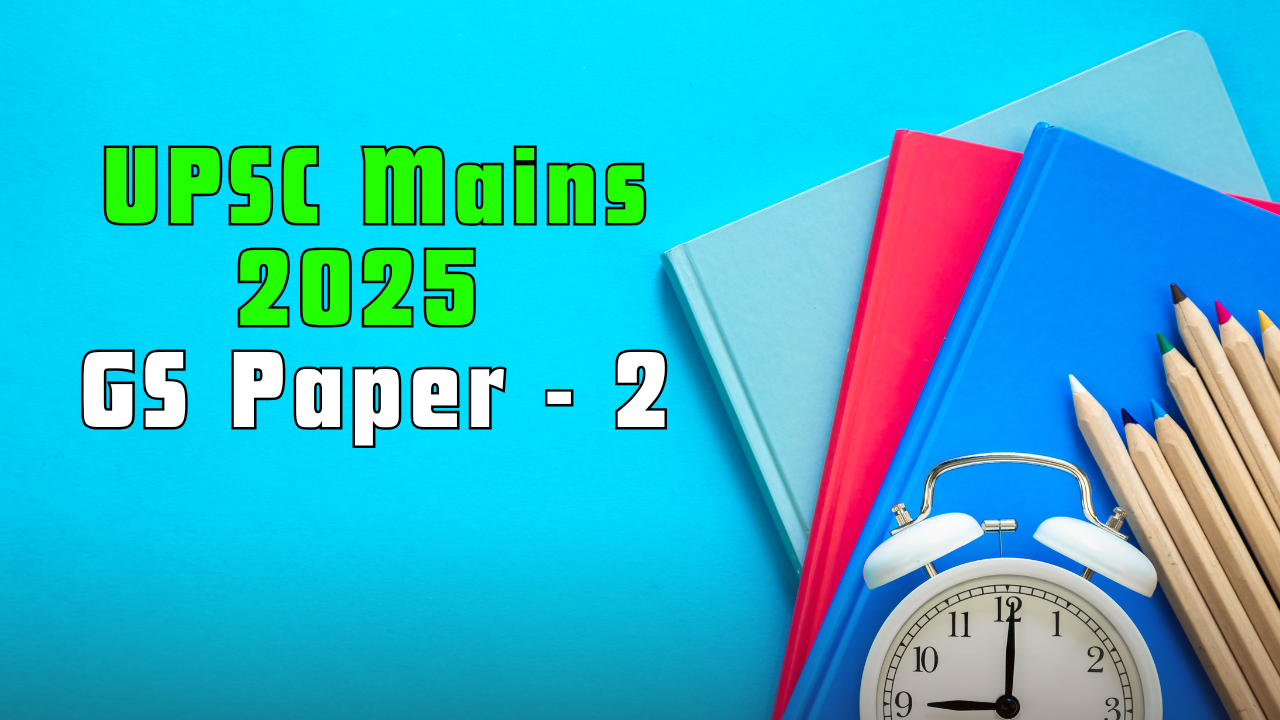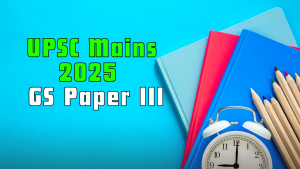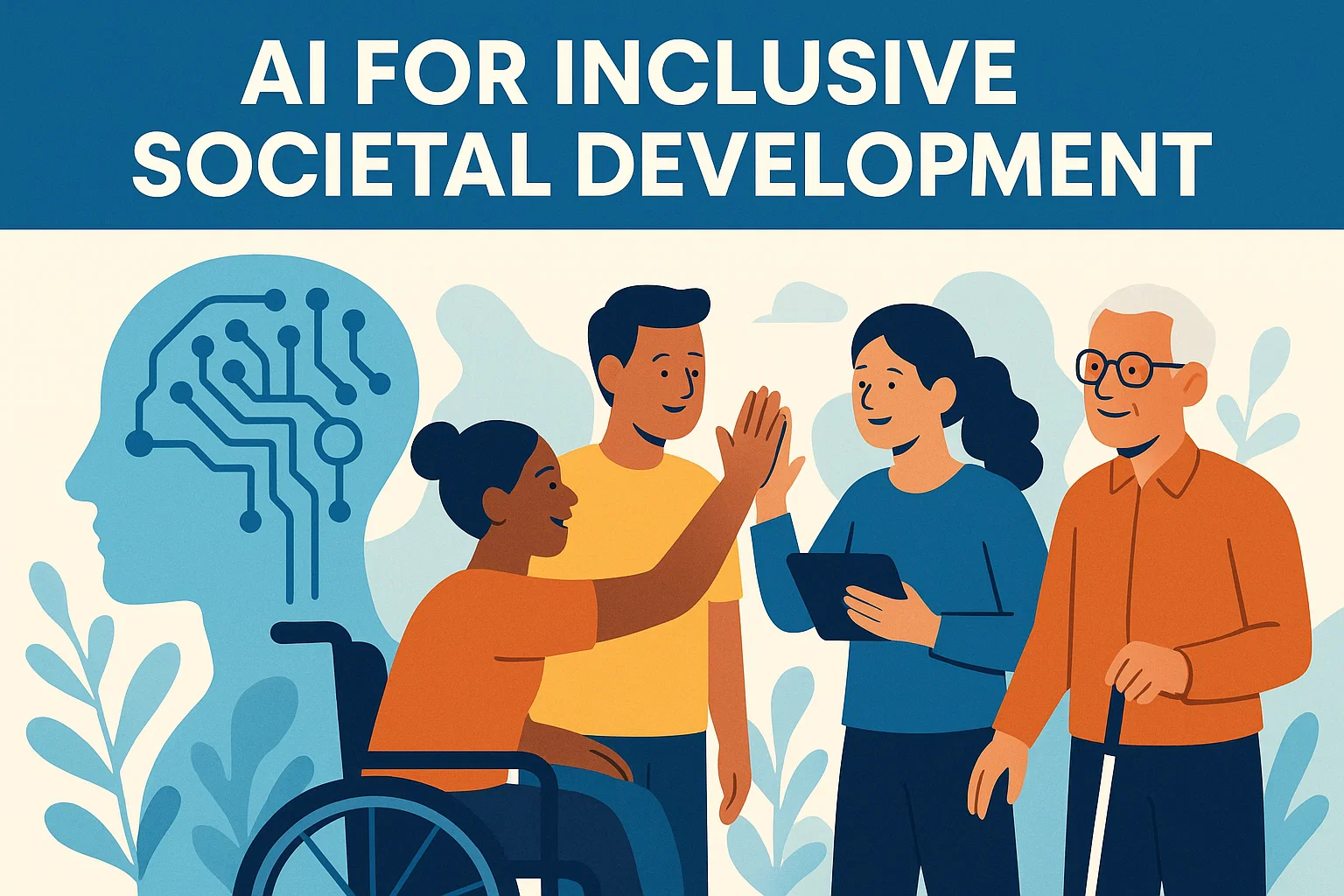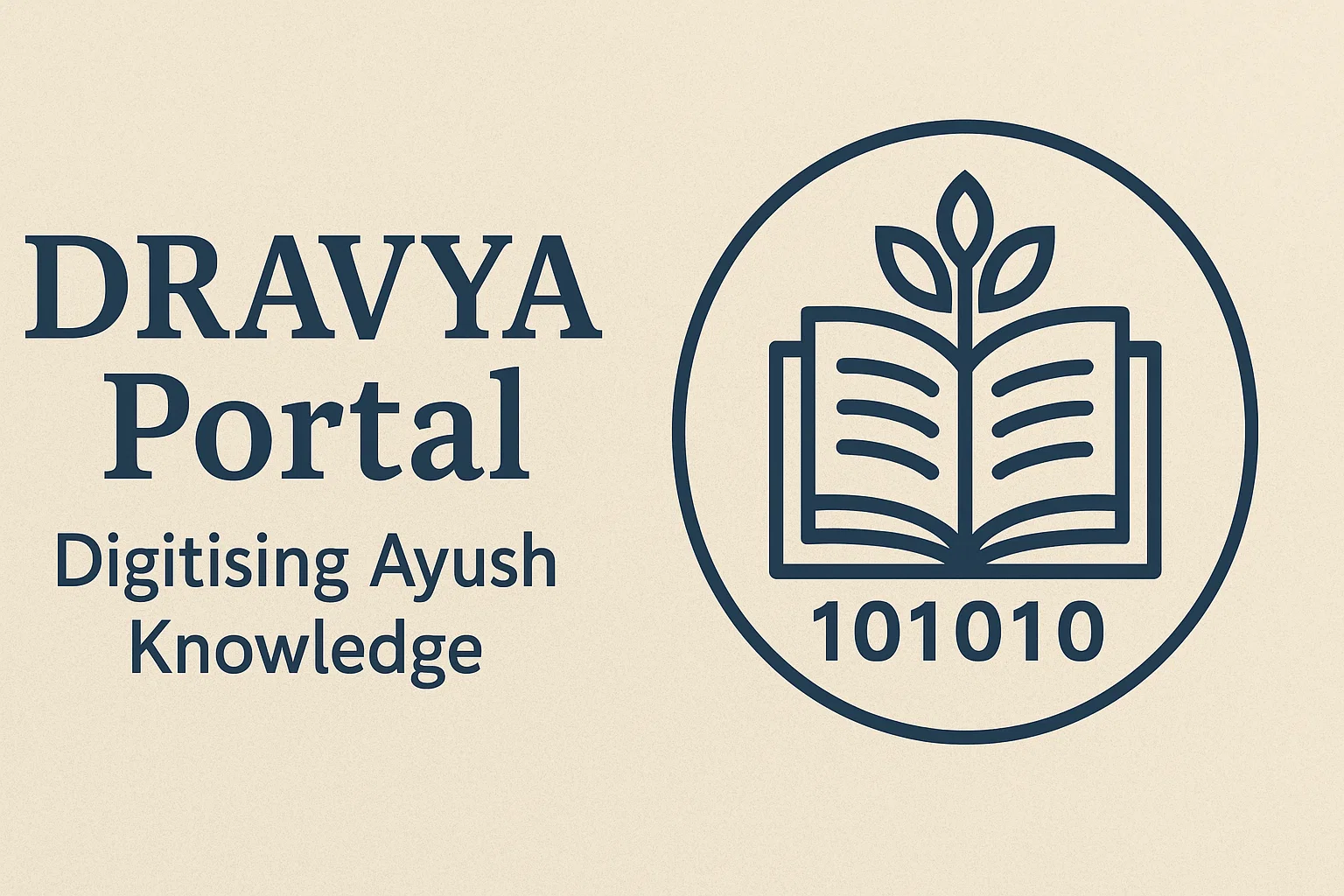UPSC Mains 2025 GS Paper II
UPSC Mains 2025 GS Paper II Question Paper with Analysis
Check the complete UPSC Mains 2025 GS Paper II question paper with detailed analysis. Understand trends, difficulty level, key themes, and answer-writing strategies for Governance, Polity, International Relations & Social Justice.
Introduction
The Union Public Service Commission (UPSC) conducted the General Studies Paper II (GS-II) of the Civil Services Mains Examination 2025 on 23rd Aug 2025. Popularly known as the Polity, Governance, Social Justice & International Relations paper, this paper tests an aspirant’s understanding of constitutional provisions, governance structures, policy-making, social issues, and India’s engagement with the world.
Unlike GS Paper I which is history & geography-heavy, GS Paper II focuses more on analytical ability, interpretation of legal-constitutional matters, and governance challenges. Aspirants are expected not just to reproduce facts but to critically examine, justify, and analyse.
The 2025 GS Paper II reflected a strong balance between static constitutional principles (like Representation of People Act, Attorney General, Constitutional Amendments) and dynamic issues (like tribunal reforms, e-governance, digital challenges, civil society, India-Africa relations, energy security). This year’s paper also tested a student’s ability to connect domestic governance with global shifts (UN reforms, waning globalization, sovereign nationalism).
Below is the complete question paper (as asked today) followed by a detailed analysis.
UPSC Mains 2025 – GS Paper II (Polity, Governance, Social Justice & IR)
(Answers to be written in the word limit specified for each question)
Section A – 10 Questions × 10 Marks each (150 words each)
1. जन प्रतिनिधित्व अधिनियम, 1951 के उद्देश्य से ‘भ्रष्ट आचरण’ की विवेचना कीजिए। विश्लेषण कीजिए कि क्या विधायकों एवं/अथवा उनके सहयोगियों की आय के ज्ञात स्रोतों के विपरीत अनुपात में संपत्ति में वृद्धि ‘असम्यक् असर’ सृजित करता है और परिणामतः भ्रष्ट आचरण है। (उत्तर 150 शब्दों में दीजिए)
Discuss the ‘corrupt practices’ for the purpose of the Representation of the People Act, 1951. Analyze whether the increase in the assets of the legislators and/or their associates, disproportionate to their known sources of income, would constitute ‘undue influence’ and consequently a corrupt practice. (Answer in 150 words)
2. न्यायालय पद्धति की तुलना में प्रशासनिक अधिकरणों की आवश्यकता पर टिप्पणी कीजिए। 2021 में अधिकरणों के बुद्धिपरक पुनर्गठन द्वारा किए गए नूतन अधिकरण सुधारों के प्रभाव का मूल्यांकन कीजिए। (उत्तर 150 शब्दों में दीजिए)
Comment on the need of administrative tribunals as compared to the court system. Assess the impact of the recent tribunal reforms through rationalization of tribunals made in 2021. (Answer in 150 words)
3.भारत और संयुक्त राज्य अमेरिका में क्षमा करने की राष्ट्रपति की शक्ति की तुलना कीजिए तथा विषमताओं को स्पष्ट कीजिए। क्या दोनों देशों में इसकी कोई सीमाएँ हैं? ‘अग्रिम माफी’ क्या होती है? (उत्तर 150 शब्दों में दीजिए)
Compare and contrast the President’s power to pardon in India and in the USA. Are there any limits to it in both the countries? What are ‘preemptive pardons’? (Answer in 150 words)
4. जम्मू-कश्मीर पुनर्गठन अधिनियम, 2019 के बाद, जम्मू-कश्मीर विधान-सभा की प्रकृति का विवेचन कीजिए। केन्द्रशासित प्रदेश जम्मू-कश्मीर की विधान-सभा की शक्तियों तथा कार्यों का संक्षेप में वर्णन कीजिए। (उत्तर 150 शब्दों में दीजिए)
Discuss the nature of Jammu and Kashmir Legislative Assembly after the Jammu and Kashmir Reorganization Act, 2019. Briefly describe the powers and functions of the Assembly of the Union Territory of Jammu and Kashmir. (Answer in 150 words)
5.”भारत का महान्यायवादी (एटर्नी जनरल) केन्द्र सरकार के कानूनी ढाँचे का मार्गदर्शन करने और कानूनी परामर्श के माध्यम से ठोस शासन सुनिश्चित करने में महत्त्वपूर्ण भूमिका निभाता है।” इस संबंध में उसकी जिम्मेदारियों, अधिकारों और सीमाओं का विवेचन कीजिए। (उत्तर 150 शब्दों में दीजिए)
“The Attorney General of India plays a crucial role in guiding the legal framework of the Union Government and ensuring sound governance through legal counsel.” Discuss his responsibilities, rights and limitations in this regard. (Answer in 150 words)
6.महिलाओं की सामाजिक पूँजी सशक्तिकरण और लैंगिक समानता को आगे बढ़ाने में सहायक है। समझाइए। (उत्तर 150 शब्दों में दीजिए)
Women’s social capital complements in advancing empowerment and gender equity. Explain. (Answer in 150 words)
7.ई-गवर्नेस परियोजनाओं में उपयोगकर्ता-केन्द्रित डिजाइनों की तुलना में प्रौद्योगिकी और बैक-एंड एकीकरण के प्रति अंतर्निहित पूर्वाग्रह है। परीक्षण कीजिए। (उत्तर 150 शब्दों में दीजिए)
e-governance projects have a built-in bias towards technology and back-end integration than user-centric designs. Examine. (Answer in 150 words)
8.नागरिक समाज संगठनों को गैर-राज्य अभिनेता की तुलना में प्रायः राज्य विरोधी अभिनेता माना जाता है। क्या आप सहमत हैं? औचित्य सिद्ध कीजिए। (उत्तर 150 शब्दों में दीजिए)
Civil Society Organizations are often perceived as being anti-State actors than non-State actors. Do you agree? Justify. (Answer in 150 words)
9.भारत-अफ्रीका डिजिटल साझेदारी आपसी सम्मान, सह-विकास और दीर्घकालिक संस्थागत साझेदारी प्राप्त कर रही है। विस्तार से बताइए। (उत्तर 150 शब्दों में दीजिए)
India-Africa digital partnership is achieving mutual respect, co-development and long-term institutional partnerships. Elaborate. (Answer in 150 words)
10.”वैश्वीकरण के क्षीण होने के साथ, शीत युद्ध के बाद की दुनिया संप्रभु राष्ट्रवाद का स्थल बनती जा रही है।” स्पष्ट कीजिए। (उत्तर 150 शब्दों में दीजिए)
“With the waning of globalization, post-Cold War world is becoming a site of sovereign nationalism.” Elucidate. (Answer in 150 words)
Section B – 10 Questions × 15 Marks each (250 words each)
11. “संवैधानिक नैतिकता एक आलम्ब है जो कि उच्च पदाधिकारियों और नागरिकों पर समान रूप से आवश्यक नियंत्रण का कार्य करता है…।”
सर्वोच्च न्यायालय के उपर्युक्त प्रेक्षण के संदर्भ में, संवैधानिक नैतिकता की अवधारणा तथा भारत में न्यायपालिका की स्वतंत्रता एवं न्यायिक उत्तरदायित्व के मध्य संतुलन सुनिश्चित करने में इसकी प्रयोज्यता की व्याख्या कीजिए।(उत्तर 250 शब्दों में दीजिए)
“Constitutional morality is the fulcrum which acts as an essential check upon the high functionaries and citizens alike…”
In view of the above observation of the Supreme Court, explain the concept of constitutional morality and its application to ensure balance between judicial independence and judicial accountability in India. (Answer in 250 words)
12. भारतीय संविधान ने कुछ प्रक्रियात्मक अवरोधों के साथ सामान्य विधायी संस्थाओं को संविधान संशोधन की शक्ति प्रदान की है। इस कथन को दृष्टिगत कर संसद के संविधान संशोधन की शक्ति पर प्रक्रियात्मक एवं सारभूत परिसीमाओं का परीक्षण कीजिए। (उत्तर 250 शब्दों में दीजिए)
Indian Constitution has conferred the amending power on the ordinary legislative institutions with a few procedural hurdles. In view of this statement, examine the procedural and substantive limitations on the amending power of the Parliament to change the Constitution. (Answer in 250 words)
13. भारत में कॉलेजियम प्रणाली के विकास की विवेचना कीजिए। भारत और संयुक्त राज्य अमेरिका के उच्चतम न्यायालय के न्यायाधीशों की नियुक्ति की प्रणाली के फायदे और नुकसान का आलोचनात्मक परीक्षण कीजिए।(उत्तर 250 शब्दों में दीजिए)
Discuss the evolution of collegium system in India. Critically examine the advantages and disadvantages of the system of appointment of the Judges of the Supreme Court of India and that of the USA. (Answer in 250 words)
14. भारत में नियोजित विकास के संदर्भ में केन्द्र-राज्य वित्तीय संबंधों के विकसित हो रहे स्वरूप (पैटर्न) का परीक्षण कीजिए। हाल के सुधारों ने भारत में राजकोषीय संघवाद को कितना प्रभावित किया है? (उत्तर 250 शब्दों में दीजिए)
Examine the evolving pattern of Centre-State financial relations in the context of planned development in India. How far have the recent reforms impacted the fiscal federalism in India? (Answer in 250 words)
15. पर्यावरण दबाव समूह क्या है? भारत में जागरूकता बढ़ाने, नीतियों को प्रभावित करने और पर्यावरण संरक्षण की वकालत करने में उनकी भूमिका का विवेचन कीजिए।
(उत्तर 250 शब्दों में दीजिए)
What are environmental pressure groups? Discuss their role in raising awareness, influencing policies and advocating for environmental protection in India. (Answer in 250 words)
16. संसाधनों के स्वामित्व पैटर्न में असमानता गरीबी का एक प्रमुख कारण है। ‘गरीबी के विरोधाभास’ के संदर्भ में चर्चा कीजिए। (उत्तर 250 शब्दों में दीजिए)
Inequality in the ownership pattern of resources is one of the major causes of poverty. Discuss in the context of ‘paradox of poverty’. (Answer in 250 words)
17. “समकालीन विकास मॉडल में, निर्णय लेने और समस्या समाधान की जिम्मेदारियाँ सूचना के स्रोत और क्रियान्वयन के निकट नहीं होतीं और (ये) विकास के उद्देश्यों को विफल कर देती हैं।” समीक्षात्मक मूल्यांकन कीजिए।(उत्तर 250 शब्दों में दीजिए)
“In contemporary development models, decision-making and problem-solving responsibilities are not located close to the source of information and execution defeating the objectives of development.” Critically evaluate. (Answer in 250 words)
18. राष्ट्रीय बाल अधिकार संरक्षण आयोग को डिजिटल युग में बच्चों के सामने आने वाली चुनौतियों का समाधान करना होगा। मौजूदा नीतियों की जाँच कीजिए और इस मुद्दे से निपटने के लिए आयोग द्वारा शुरू किए जा सकने वाले उपायों के सुझाव दीजिए।(उत्तर 250 शब्दों में दीजिए)
The National Commission for Protection of Child Rights has to address the challenges faced by children in the digital era. Examine the existing policies and suggest measures the Commission can initiate to tackle the issue. (Answer in 250 words)
19. “ऊर्जा सुरक्षा भारत की विदेश नीति का मुख्य स्तंभ है, और यह मध्य पूर्वी देशों में भारत के व्यापक प्रभाव से जुड़ा हुआ है।” आप आने वाले वर्षों में भारत की विदेश नीति की दिशा के साथ ऊर्जा सुरक्षा को कैसे एकीकृत करेंगे?(उत्तर 250 शब्दों में दीजिए)
“Energy security constitutes the dominant kingpin of India’s foreign policy, and is linked with India’s overarching influence in Middle Eastern countries.” How would you integrate energy security with India’s foreign policy trajectories in the coming years? (Answer in 250 words)
20. “पूर्व और पश्चिम के बीच नाजुक असंतुलन और यू० एस० ए० बनाम रूस-चीनी गठबंधन के बीच उलझन के कारण संयुक्त राष्ट्र में सुधार प्रक्रिया अभी भी अनसुलझी है।” इस संबंध में पूर्व-पश्चिम नीति टकरावों की जाँच और आलोचनात्मक मूल्यांकन कीजिए। (उत्तर 250 शब्दों में दीजिए)
“The reform process in the United Nations remains unresolved, because of the delicate imbalance of East and West and entanglement of the USA vs. Russo-Chinese alliance.” Examine and critically evaluate the East-West policy confrontations in this regard. (Answer in 250 words)
Analysis of UPSC Mains 2025 GS Paper II
1. Difficulty Level
-
Moderate to Difficult.
-
Questions required analytical depth more than rote knowledge.
-
Some questions were direct (Attorney General, Tribunals, J&K Assembly) while others were abstract & conceptual (civil society, sovereign nationalism, paradox of poverty).
2. Section-Wise Trend
-
Polity & Constitution – Strong focus: RPA 1951, Pardoning Power, J&K Act, Constitutional Morality, Collegium System, Constitutional Amendments.
-
Governance & Social Justice – Women’s social capital, e-Governance, CSOs, NCPCR, Poverty paradox.
-
International Relations – India-Africa partnership, Energy security, UN reforms, Globalization vs Sovereign Nationalism.
3. Overlap with Current Affairs
-
J&K Assembly (recent delimitation + elections debate).
-
Tribunal reforms (2021, recent SC judgments).
-
Pardoning Power (global debates on Presidential pardons).
-
Globalization decline (post-Covid, trade wars, nationalism rise).
-
UN reforms (Ukraine war, China-US rivalry).
4. Comparison with Previous Years
-
Like 2023 & 2024, the mix of static + dynamic continued.
-
Increased weightage on international relations (Africa, Middle East, UN, global shifts).
-
Social issues questions were less direct, more analytical.
5. Key Takeaways for Aspirants
-
Focus on linking static polity with contemporary events.
-
Practice writing analytical essays in 150 words – crisp, balanced, multidimensional.
-
Governance & IR sections are becoming increasingly dynamic → regular newspaper + policy report reading is crucial.
-
Expect interdisciplinary questions (law + governance + international issues).
Subscribe to our Youtube Channel for more Valuable Content – TheStudyias
Download the App to Subscribe to our Courses – Thestudyias
The Source’s Authority and Ownership of the Article is Claimed By THE STUDY IAS BY MANIKANT SINGH





